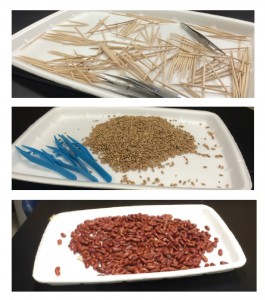In My Classroom – #7 (Natural Selection Activity)
Welcome to the KABT new blog segment, “In My Classroom”. This is a segment that will post about every two weeks from a different member. In 250 words or less, share one thing that you are currently doing in your classroom. That’s it.
The idea is that we all do cool stuff in our rooms, and to some people there have been cool things so long that it feels like they are old news. In this segment, if you are tagged all you need to do is share something you’ve done in your classroom in the last two weeks. It must be recent, but that’s it. If you are tagged, you’ve got two weeks to post your entry. Who knows… your supposedly mundane idea, lesson, or lab might be exactly what someone else really needs. Keep it brief, keep it honest about the time window, and share it out! Here we go:
This year, I tried the bird beak adaptation activity for natural selection for the first time. I looked at several variations of the activity online, and took pieces of some and added in my own. I not only wanted to show adaptation, but also how adaptation might be different in different environments (islands with different food sources). So here is what we did.
All of the “birds” went to the library with their “beaks” (tweezers). This was the mainland, a big continent. We noticed that some beaks were slightly different than others.

We then were swept up in a hurricane and brought to the classroom, where we found refuge on different islands (tables), too far away for any birds to travel back and forth with normal circumstances. Each table had a different environment, and different food source (big beans, little beans, toothpicks, pennies, paper clips, barley).
The students then took turns “eating”. The one who go the most food had 2 offspring. The bird who got the least died before they could reproduce. The one in-between had one offspring. The offspring were exactly like the parents. These rules made it super simple, which was nice for an introduction activity. Throughout the activity we talked about how simplified this model was, and how real life would be different.
Next, I introduced some mutations (a spoon and a test tube clamp). 
They acted out three generations. Obviously the spoon was very successful with big beans but pretty detrimental with toothpick prey. We had a nice conversation about how mutations are neither good nor bad, it depends on the environment. They also got to see one way geographic isolation can lead to speciation. We followed up with a more real life example using some HHMI Pocket Mouse activities. This activity was done before we really talked about evolution. It was nice way to begin our discussion. I think having the different tweezer beaks at the beginning was confusing, so next year I think I’ll simplify it further and have all the tweezers the same. I would also like to add in a more complex natural selection activity later on. What’s your favorite natural selection activity?
Tag Andrew Taylor, you’re it! Tell us about something you’re doing in your classroom.

Jesi,
Why am I not surprised you chose to share an evolution activity. Nice adaptation and nice reflection….
BW